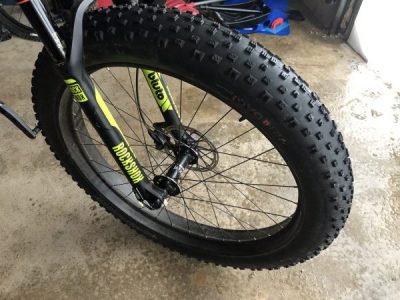When it comes to buying a fat bike, it’s pretty easy to initially notice them compared to other riders on two wheels. Those thick tires handle any type of terrain, and they are becoming more and more common throughout the world.
What used to be a very niche product is slowly creeping into the mainstream. They still are not extremely popular just yet, but more companies are fully embracing the thick tires, durable builds and overall uniqueness of a fat bike.
Thinking about making a purchase? There’s a lot of information out there that one needs to consider before putting down a decent chunk of money. There are enough companies now making quality fat bikes that the decision is harder than ever.
No one should dive into the buying process without spending some time learning about fat bikes, understanding what to look for, reading reviews and hopefully, testing a few out before ordering.
What Is the True Definition of a Fat Bike?
The term fat bike is pretty broad, but they are pretty easy to distinguish. Any bike tire that is over 3 inches wide falls in the fat bike category by most definitions.
A typical mountain bike tire is 2.25 inches to 2.5 inches wide, whereas fat bikes will range anywhere from just over 3 inches up to 5 inches. This is a pretty significant difference, and it requires an entirely different frame and fork that can handle this width. It even makes the pedals slightly further apart because of the layout of the bike.
Since these fat bikes have wide tires, another defining feature of this option is the ability to ride on any terrain. A proper fat bike can handle anything, including pavement, sand, snow, and mud.
They excel on very rough terrain, taking the impact of stones and roots better than any other type of bike out there. It smooths out the ride and makes it very comfortable for people to ride in adverse conditions.
There are no industry standards manufacturers must abide by to officially receive the fat bike label. The market is still pretty niche, and most people are just looking for a set up that works for them individually depending on where they live and where they like to ride.
What to Look For When Buying a Fat Bike For the First Time
Now that the definition is out of the way, the next step is trying to understand all the different major components that go into a standard fat bike build. Each plays a major role in how that fat bike performs, as well as how comfortable the ride is in general.
Some of these differences might seem subtle on paper, so remember to look for a way to test ride as many fat bikes as possible before committing. Nothing can substitute for real-world testing. Fat bikes are different than any other bike out there, so it’s important to get something that isn’t too overwhelming.
Understanding Tires and Tire Pressure

Tire pressure is one of the biggest adjustments that fat bike users must make to understand how to get the most out of it. Unlike other bikes, the goal is to use tires that are very low pressure.
PSI can be in the 5- to 10-pound range. This makes sense for very soft, loose conditions, but still is unheard of with other bike setups. For example, road bike tires are routinely inflated well over 100 PSI.
Road bikes also have a pretty standard PSI. That is because surfaces might change a little bit, but not enough to alter how the bike performs. Since fat bikes can go anywhere, it’s worth making the adjustments before taking off on a journey so that it is prepared for the surface ahead.
On the softest, loosest conditions, expect to put the bike as low as 5 PSI. When riding on harder surfaces, including cement, going up to 25 or 30 PSI is the best way to go. Go any higher than that is going to make the tires vulnerable to pop, and not provide much if any, additional benefits.
Most riders who love their fat bike will cite the low-pressure system as one of the biggest selling points of a fat bike in general. It does make a much more comfortable ride, but there are some things to keep in mind.
For starters, fat bikes weigh more because they have bigger, heavier tires, rims, tubes, and more. The bike will lag a bit for somebody who is not used to riding something this heavy.
Low pressure in thick tires is also going to add a lot of rolling resistance. It’s a trade-off between that and having comfort and customization. It’s going to be nearly impossible to beat someone in a race on flat, solid terrain if they have a road bike, but most people are still able to go fairly fast on a fat bike.
All in all, a fat bike is generally going to be a tougher workout overall than any other type of bike. That is because the bike is heavier, the terrain is usually more challenging, it’s harder to get a bike up to a fast-rolling speed, and the body is moving around on every twist and turn.
Those who are looking at using a bike as part of a weight-loss program will definitely like this aspect of it.
What Type of Suspension is Necessary?

Investing in the right suspension will make a pretty big difference for most fat bike riders. Fat bikes, in general, are pretty rigid, but some come with suspension forks that help a little. If a person really wants full suspension with their fat bike, they can find them, although it is a bit difficult.
So why would a fat bike rider want suspension? Comfort and control are the two biggest reasons. When trying to handle very rugged terrain, it makes sense to have a decent amount of suspension. Mountain bikes rely on suspension, and so do fat bikes if they are going to take their place.
If the majority of the fat bike riding will be on smoother trails, Suspension might not be as important. A lot of trails can become a little more rugged than most people realize though, which makes suspension necessary in some cases.
The reason why some fat bike riders go without suspension is that it increases the weight of the bike, and it just adds to the overall maintenance. If it’s not going to provide that much value, most people are willing to do without so that they can have a lighter bike.
The good news is that today’s fat bikes are designed for those people who might not be happy with their decision in the beginning. A rigid fat bike can have a suspension fork installed if needed, and it’s not going to cost that much in the end. Unfortunately, those people who have older fat bikes might not be able to do the same thing.
Frame Material
The frames of a fat bike are made up of pretty much the same material as any other type of bicycle out there. People can choose from aluminum, steel, carbon fiber or even titanium.
Many people have their preferences, but they do all have a pretty distinct feel. A frame is important, and can seriously affect the overall ride.
Steel
A steel frame is going to be very strong and durable, and it usually is one of the best values out there. If a person is looking to spend under $1000 on a fat bike, this might be the best way to go.
Steel also holds up well when trying to carry a lot of weight at once. This comes particularly in handy for anyone who looks to add a rack to their fat bike for a more daily commute. Not everyone will need that added stability, but it is nice to rely on if something comes up.
Not only does steel tend to be a little heavy, but it also isn’t very flexible. That makes riding a little stiffer of a challenge for some people. If this is the first fat bike purchased, it might not be that noticeable. When transitioning from something different, the steel frame will be noticeable.
Aluminum
Aluminum is the other popular material that falls in the inexpensive category. It’s more flexible than steel and weighs slightly less, but most people believe it’s not as strong.
Some people also feel like aluminum is not as strong and sturdy. The bike will flex a bit more and handle rough terrain better, but you can have a cheaper type of feel to it that some people just don’t like.
Carbon fiber
Anyone who has bike experience of any kind certainly knows the importance of carbon fiber in a bike. Not only does it significantly reduce the weight, but it smooths out the ride in ways that steel and aluminum simply can’t.
Carbon fiber just has that premium look and feel on any bike. It does come at a price, sometimes hundreds of dollars more depending on how much carbon fiber is on the bike. To cut down on cost a little, some people may opt for just a carbon fork, or a carbon seat.
Titanium
There are not too many titanium frame fat bikes on the market just yet, but those willing to spend a decent amount of money can certainly find one. They are extremely expensive, but some people do swear by them. They act in a lot of ways like carbon fiber bikes, only more of
an upgrade. Until it is more readily available, it’s only going to appeal to a very select few. Even professional bike riders might opt for carbon fiber over titanium, depending on what they are used to.
Gears and Brakes

There is not much variety in gears and breaks with fat bikes since a lot of riders are looking for the same type of thing. Gears, in general, tend to be larger with fat bikes, to accommodate the tires. This is something that only really matters to those building or upgrading their current set up, because everything else is handled by the manufacturer.
The vast majority of fat bike riders also count on disc brakes, regardless of surface. They are usually the most dependable and are easy to service and keep clean when changing with the seasons.
One thing to keep in mind is that DOT fluid comes in handy compared to mineral oil in very cold conditions. If the majority of the riding occurs in the winter and on snow, it might be worth looking into. Manufacturers SRAM and Magura use this fluid, while Shimano uses mineral oil. It is a minor change, but it does make a difference.
Breaking Down the Cost of a Fat Bike
In the early days, many people were turned off by the high price tag that accompanied every single fat bike out there. It is still a pretty hard niche to break into with an entry-level model, but they are coming down in price. That’s good news for growth, as some are getting frustrated with the inability to take things to another level.
The average price of an entry-level fat bike will be in the $500-$750 range for the most part. There will be nothing special with these bikes, and although they are durable, they won’t last nearly as long as some of the more expensive models. There are also limited customizations available with an entry-level bike, as is the case with any other type of bike that is entry-level as well.
Perhaps the biggest drawback to a cheaper fat bike is that it becomes a little too heavy. Some of the entry-level bikes way close to 50 pounds, and it might not seem like a huge deal at first, but it starts to pile on when using it for long rides. The reason why it weighs so much is the lack of high-quality parts. Frames are made of almost entirely steel, and even heavier screws, pedals, handlebars and more are used.
To step it up to another level, expect to pay $1000 or more. This is a general starting point at most bike shops, as they offer something that will be a bit more customizable. It also will have a few were the upgrades people can mess around with if they wish. In this range, tires width can be messed around a bit, making sure that the right size is utilized for proper conditions.
Expect to spend at least $1000 on a bike that will be usable all year long. Some of the cheapest fat bike options might not have the ability to transition to different seasons and different surfaces. It’s also less likely that they can use tires that have studs in them to handle snow, as an example.
Finally, jumping up to about $2000 or more is the best way to get a fat bike that is truly revolutionary. These are the best of the best, but they are going to set anyone back at least a little. A casual rider might not notice the big difference that makes a bike so expensive, but those looking for a true edge will realize why it costs more.
For starters, the components and materials used are just hard quality. Carbon, in particular, shoots the price of a bike up considerably. At the top of the line, a lot of the bike is made of carbon fiber, making for the smoothest and latest ride possible.
Whereas entry-level bikes can weigh around 50 pounds, premium fat bikes are as low as 30 or 35 pounds. They really can’t get any lighter than that right now because of their bulkiness, but it improves performance considerably.
Those brand new to fat biking should probably set a pretty low budget overall. That doesn’t mean buying the cheapest option available, but take a look around and see what stands out. If possible, go to a local bike shop to try out a similar bike as well. That way, a person is prepared for what might be ahead of them when it comes to handling everything.
Getting a Customized Fit

Bikes come in many shapes and sizes, but one of the most important things when it comes to buying a new bike is making sure that everything is customized to fit a person’s body. A bike might need just a few tweaks, or it might need changing up considerably to ride comfortably for hours and hours.
The first general step is to do the basic measurements to figure out what fat bike size to buy. Make sure to measure not only overall height but inseam as well. This will help determine what initial size makes the most sense.
After that, handlebar adjustments, seat adjustments, pedal changes and more can all turn a bike into something that is perfectly molded for an individual. This is great news for anyone who wants to have maximum efficiency with every single pedal. If the bike doesn’t fit properly, it puts more stress on the body and makes riding just a little more inefficient.
Unless a person has experience making adjustments to bikes, it is probably best to go with a local bike shop that will be able to help with everything. They will simplify the entire process, even helping to take measurements that you might overlook at first.
Enjoying the Shopping Experience
Above all else, curious shoppers should take the proper amount of time to research different options before making a purchase. It’s going to make life easier in the long run, as most people will be hoping for at least a couple of years of use out of their first purchase.
Fat biking continues to expand, and local bike shops are very willing to help those who are curious. There’s also a wealth of information online, and particularly this website.
Not only do fat bike riders love the fact that they can go anywhere, but they can ride at any time of the year as well. For the work out alone, it’s worth going down the route of riding a fat bike. The fact that it also opens up all sorts of new places to explore is the icing on the cake for many first-time buyers eager to get out there.

